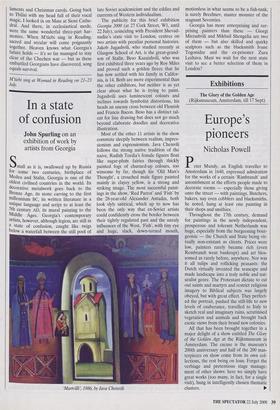Exhibitions
The Glory of the Golden Age (Rijksmuseum, Amsterdam, till 17 Sept)
Europe's pioneers
Nicholas Powell
Peter Mundy, an English traveller to Amsterdam in 1640, expressed admiration for the works of a certain `Rimbrandt' and astonishment at the efforts people made to decorate rooms — especially those giving onto the street — with paintings. Butchers, bakers, nay even cobblers and blacksmiths, he noted, hung at least one painting in their shops and smithies.
Throughout the 17th century, demand for paintings in the newly independent, prosperous and tolerant Netherlands was huge, especially from the burgeoning bour- geoisie — the Church and State being vir- tually non-existant as clients. Prices were low, painters rarely became rich (even Rembrandt went bankrupt) and art blos- somed as rarely before, anywhere. Nor was it all tulips and rollicking peasants: the Dutch virtually invented the seascape and made landscape into a truly noble and nat- uralist genre. The Protestant dictate to cut out saints and martyrs and restrict religious imagery to Biblical subjects was largely obeyed, but with great effect. They perfect- ed the portrait, pushed the still-life to new levels of exuberance, travelled to Italy to sketch real and imaginary ruins, scrutinised vegetation and animals and brought back exotic views from their brand new colonies.
All that has been brought together in a major delight of a show entitled The Glory of the Golden Age at the Rijksmuseum in Amsterdam. The excuse is the museum's 200th anniversary and half of the 200 mas- terpieces on show come from its own col- lections, the rest being on loan. Forget the verbiage and pretentious stage manage- ment of other shows: here we simply have great works (too many, in fact, for a single visit), hung in intelligently chosen thematic clusters. ► Those sensible Dutch burghers rejected mannerism, the artistic fashion of the day, out of hand. The first canvas on show at the Rijksmuseum is Joachim Wtewael's mannerist 'Saint Sebastian', 1600, in which a rosy-cheeked martyr, being strung up and seemingly enjoying it, gazes longingly at a low-flying cherub. Dead opposite is Hen- drick ter Brugghen's innovative treatment of Sebastian being cared for by Saint Irene: a last rope still lashes a ghastly grey right hand, the slumped and suffering body cre- ates a stark pictorial framework of diagonal lines.
Protestantism bit deep and it was polite practice in Holland to 'suppress one's mirth'. Many of Frans Hals's characters smirk, of course, as do those in the works of the small number of Dutch artists inspired by the light and shade effects of Caravaggio — Dirck van Baburen's 'The Procuress', 1622, for example, or Hendrick ter Brugghen's 'The Concert' c.1626-27. But in such a Calvinist world, music-mak- ing and drinking were symbolic of carnal pleasure — such canvases were a moralis- ing form of soft porn.
They even considered smiling akin to foolishness, which makes Frans Hals's `Marriage portrait of Isaac Massa and Beatrix van der Laen', c.1622, hung in the section 'New Faces', devoted to portrai- ture, all the more remarkable. The couple loll happily out of doors amid flowers sym- bolic of fidelity, he with a contented wide- eyed gaze and she positively grinning. Elsewhere in the exhibition, Rembrandt in particular transforms portraiture of Hol- land's great and good into great art: not only in the mega-masterpiece 'The Night Watch', 1642, but also in works such as `The anatomy lesson of Dr Nicolaes Tulp', 1632, in which the pink-fleshed liveliness of the eight medical worthies is in stark con- trast with the subject of their study — the barely cold body of one Adriaan Adriaansz, who had been hanged that very morning.
There is jollity of a promiscuous nature in the works of the section 'Seemingly everyday 1650-1670', 'genre' paintings often looked down on in their day which represented scenes of daily life, peasant life in particular. Perversely, such canvases could also be loaded with symbolic and lit- erary references — so many moral warn- ings about the consequences of committing the acts which the characters depicted are so obviously enjoying: so much was certain- ly true of the so-called 'brothel scenes', which range from the merely suggestive to the topless and boisterous.
The parts of this exhibition devoted to seascapes, landscapes and marine paintings are among the most fascinating. They reveal how the Dutch, many years before anyone else, were switching from ideal to naturalistic representations of land and sea, delighting in the rendition of light effects for their own sake and seeking out unusual light effects — the setting sun which diffus- es Aelbert Cuyp's 'River landscape with horsemen', c.1655, for example, the milky duskiness of Adam Pynacker's 'Boatmen moored on a lake shore', c.1660, or the stormy, almost Gothic light and dark of Jacob van Ruisdael's 'The Jewish Ceme- tery', c.1660-70. Jan van Goyen's 'View of the Haarlemmermeer', 1646, has masses of clouds of which a French Barbizon painter would have been proud.
Marriage portrait of Isaac Massa and Beatrix van der Laen' by Frans Hats, Rijksmuseum With foreign trade booming and the Dutch Navy knocking spots off the French and the British, the sea was a natural pre- occupation. Ludolf Bakhuysen's 'Ships in distress in a raging storm', c.1690, has boats thrashing about on crashing waves with a foaming vigour which other European painters only picked up on a century later. Three hundred years ago, in commerce, war and art, the Dutch were evidently Europe's pioneers.



























































 Previous page
Previous page